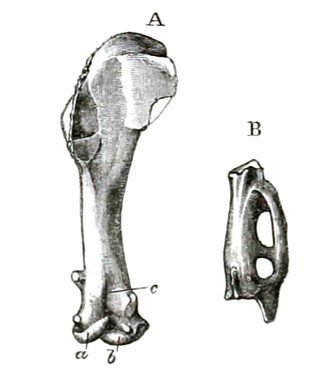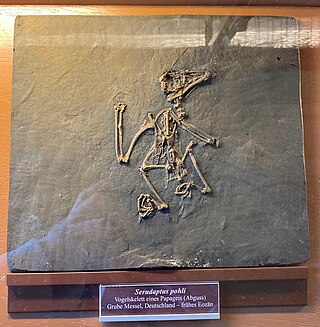
The Pelecaniformes are an order of medium-sized and large waterbirds found worldwide. As traditionally—but erroneously—defined, they encompass all birds that have feet with all four toes webbed. Hence, they were formerly also known by such names as totipalmates or steganopodes. Most have a bare throat patch, and the nostrils have evolved into dysfunctional slits, forcing them to breathe through their mouths. They also have a pectinate nail on their longest toe. This is shaped like a comb and is used to brush out and separate their feathers. They feed on fish, squid, or similar marine life. Nesting is colonial, but individual birds are monogamous. The young are altricial, hatching from the egg helpless and naked in most. They lack a brood patch.

Traditionally, the bird order Apodiformes contained three living families: the swifts (Apodidae), the treeswifts (Hemiprocnidae), and the hummingbirds (Trochilidae). In the Sibley-Ahlquist taxonomy, this order is raised to a superorder Apodimorphae in which hummingbirds are separated as a new order, Trochiliformes. With nearly 450 species identified to date, they are the most diverse order of birds after the passerines.

The swifts are a family, Apodidae, of highly aerial birds. They are superficially similar to swallows, but are not closely related to any passerine species. Swifts are placed in the order Apodiformes with hummingbirds. The treeswifts are closely related to the true swifts, but form a separate family, the Hemiprocnidae.

Aegialornis is a genus of prehistoric apodiform birds. It formed a distinct family, the Aegialornithidae, and was in some ways intermediate between modern swifts and owlet-nightjars, lacking the more extreme adaptations to an aerial lifestyle that swifts show today, but already having sickle-shaped wings like them. They do not appear to be a direct ancestor of modern swifts, however, but rather a group that retained an overall basal morphology. Altogether, they were not too dissimilar from modern treeswifts.

The Pelagornithidae, commonly called pelagornithids, pseudodontorns, bony-toothed birds, false-toothed birds or pseudotooth birds, are a prehistoric family of large seabirds. Their fossil remains have been found all over the world in rocks dating between the Early Paleocene and the Pliocene-Pleistocene boundary.
Paleontology or palaeontology is the study of prehistoric life forms on Earth through the examination of plant and animal fossils. This includes the study of body fossils, tracks (ichnites), burrows, cast-off parts, fossilised feces (coprolites), palynomorphs and chemical residues. Because humans have encountered fossils for millennia, paleontology has a long history both before and after becoming formalized as a science. This article records significant discoveries and events related to paleontology that occurred or were published in the year 2005.
Primapus is an extinct genus of apodiform bird from the Early Eocene of the United Kingdom. Its fossils were found in the London Clay, which was deposited around 50 million years ago. The type species is P. lacki.

Dasornis is a genus of prehistoric pseudotooth birds. These were probably close relatives of either pelicans and storks or waterfowl; they are placed in the order Odontopterygiformes to account for this uncertainty.
Gigantornis eaglesomei is a very large prehistoric bird described from a fragmentary specimen from the Eocene of Nigeria. It was originally described as a representative of the albatross family, Diomedeidae, but was later referred to the pseudotooth or bony-toothed bird family, Pelagornithidae. Gigantornis is one of the largest pseudotooth birds, with an inferred wingspan of about 6 m (20 ft) it is among the largest birds ever.

Lithornis is a genus of extinct paleognathous birds. Although Lithornis was able to fly well, their closest relatives are the extant tinamous and ratites.

Lithornithidae is an extinct, possibly paraphyletic group of early paleognath birds. They are known from fossils dating to the Upper Paleocene through the Middle Eocene of North America and Europe, with possible Late Cretaceous representatives. All are extinct today; the youngest specimen is the currently unnamed SGPIMH MEV1 specimen from the mid-Eocene Messel Pit site.
Eostrix is a genus of extinct primitive owls in the family Protostrigidae, along with Oligostrix and Minerva. These owls date from the early Eocene of the United States, Europe, and Mongolia. They have been described based on fossil remains. The genus was created by Pierce Brodkorb in 1971 to place a fossil species known until that time as Protostrix mimica.

Strisores, sometimes called nightbirds, is a clade of birds that includes the living families and orders Caprimulgidae, Nyctibiidae (potoos), Steatornithidae (oilbirds), Podargidae (frogmouths), Apodiformes, as well as the Aegotheliformes (owlet-nightjars) whose distinctness was only recently realized. The Apodiformes and the Aegotheliformes form the Daedalornithes.

Halcyornithidae is an extinct family of telluravian birds thought to be related to the Psittaciformes (parrots), Passeriformes (songbirds), and to the extinct Messelasturidae. Halcyornithids have been found in various Eocene formations in Europe and North America. Widespread and diverse in the Early Eocene of North America and Europe, halcyornithids are not found in locales later than the Middle Eocene. Halcyornithids were small, arboreal birds with zygodactyl feet, with two toes facing forwards and two facing back, a trait shared with other tree-dwelling families of Eocene birds like the Zygodactylidae and the messelasturids. The skull of halcyornithids features a ridge of bone above the eye called the supraorbital process, similar to birds of prey. The relationships of the halcyornithids to other birds remain uncertain. Halcyornithids have been proposed as relatives to owls and as a lineage closer to parrots than to songbirds. Most recently, halcyornithids have been identified as the sister group of the clade including parrots and songbirds. It is also possible that Halcyornithidae is paraphyletic with respect to the Messelasturidae.
Eocypselus rowei is an extinct bird believed to be ancestral to modern hummingbirds and swifts. It was a small bird, less than 5 in (13 cm) in length, and probably had black feathers. The bird was first described in 2013 and lived approximately 50 million years ago, during the Eocene epoch.
This is an overview of the paleofauna of the Eocene Messel Formation as explored by the Messel Pit excavations in Germany. A former quarry and now UNESCO World Heritage Site, the Messel Formation preserves what once were a series of anoxic lakes surrounded by a sub-tropical rainforest during the Middle Eocene, approximately 47 Ma.

Ypresiglaux is an extinct genus of strigiform bird from the Early Eocene London Clay Formation of Essex, United Kingdom and Nanjemoy Formation of Virginia, United States. The genus contains two species: Y. michaeldanielsi, known from a partial skeleton, and Y. gulottai, known from a distal tarsometatarsus.
Eocypselus vincenti is an extinct species of prehistoric bird believed to be the ancestors of modern hummingbirds and swifts within the family Eocypselidae. It is known from the Fur Formation in the early Eocene of Denmark. It was described from a wing and pectoral bone from an individual found in the London Clay formation. The genus Eocypselus is thought to represent the earliest divergence between Apodiformes in hummingbirds and swifts.
Eofringillirostrum is an extinct species of bird known from the Early Eocene Green River Formation of the Western United States and from the Messel Pit in Germany. The genus contains two species, Eofringillirostrum boudreauxi and Eofringillirostrum parvulum. They are the earliest known fossil birds to have a finch-like beak.










